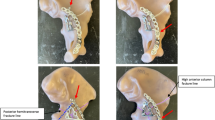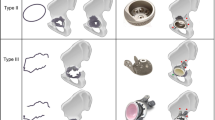Abstract
Purpose
This study was designed to evaluate the clinical and radiographic results of arthroscopic treatment of femoroacetabular impingement (FAI) using the technique of initial access to the peripheral compartment. It is based on a single surgeon large case series with a minimum of 2 years follow-up.
Methods
Prospective longitudinal study with consecutive patients. Inclusion criteria were the presence of FAI syndrome that had failed non-operative treatment and had a hip arthroscopy with initial access to the peripheral compartment. Exclusion criteria were previous hip surgery, patients younger than 16 or older than 60 years, Tönnis grade ≥ 2 osteoarthritis, hip dysplasia based on radiographic evidence of LCEA less than 25° and workers compensation cases. One hundred and sixty hips met the inclusion criteria, 84 were female and 70 were male patients (six bilateral cases), with a median age of 36 years (range 16–59).
Results
The median alpha angle correction was 22.6º (range 5.9–46.7) (p < 0.01) and the average LCEA correction when acetabuloplasty was undertaken was 6.5º (range − 1.4–20.8) (p < 0.01). The mean NAHS at baseline was 56.1 (range 16–96) and improved to 83.2 at the last follow up (range 44–100) for the patients that had no additional procedure (p < 0.01). The mean average improvement was 27.7º points (range − 16–73). No iatrogenic labral perforation and no full-thickness chondral damage were recorded during the arthroscopic procedures.
Conclusions
Favourable outcomes are reported for the arthroscopic treatment of FAI with initial access to the peripheral compartment. The technique is protective against iatrogenic chondral and labral damage, more conservative to the joint capsule, but the mean traction time was relatively long when suture anchors were used. The results are comparable to the classic initial central compartment approach.
Level of evidence
Level IV.


Similar content being viewed by others
References
Aguiar T, Dantas P (2014) Arthroscopic resection of intra-articular osteochondromas of the hip. Arthrosc Tech 3(3):e347–e350
Busse J, Gasteiger W, Tönnis D (1972) A new method for roentgenologic evaluation of the hip joint-the hip factor. Arch Orthop Unfallchir 72(1):1–9
Christensen CP, Althausen PL, Mittleman MA, Lee JA, McCarthy JC (2003) The nonarthritic hip score: reliable and validated. Clin Orthop Relat Res 406(1):75–83
Dantas P, Gonçalves S, Mascarenhas V, Barreira M, Marin-Peña O (2020)Hip arthroscopy with initial access to the peripheral compartment: a detailed step-by-step technique description. Arthrosc Tech 9(11):e1651–e1655
Dienst M, Kusma M, Steimer O, Holzhoffer P, Kohn D (2010) Arthroscopic resection of the cam deformity of femoroacetabular impingement. Orthop Traumatol 22(1):29–43
Dienst M, Gödde S, Seil R, Hammer D, Kohn D (2001) Hip arthroscopy without traction: in vivo anatomy of the peripheral hip joint cavity. Arthroscopy 17(9):924–931
Dienst M, Seil R, Kohn DM (2005) Safe arthroscopic access to the central compartment of the hip. Arthroscopy 21(12):1510–1514
Dorfmann H, Boyer T (1999) Arthroscopy of the hip: 12 years of experience. Arthroscopy 15(1):67–72
Frandsen L, Lund B, Grønbech Nielsen T, Lind M (2017) Traction-related problems after hip arthroscopy. J Hip Preserv Surg 4(1):54–59
Geada NG, Dantas P, Mascarenhas V, Campos V, Gonçalves S (2018) Is It safe to perform an early arthroscopy after a traumatic hip dislocation with an associated pelvic ring injury? Report of our technique. Arthrosc Tech 7(6):e679–e684
Griffin DR, Dickenson EJ, O’Donnell J, Agricola R, Awan T, Beck M, Clohisy JC, Dijkstra HP, Falvey E, Gimpel M, Hinman RS, Hölmich P, Kassarjian A, Martin HD, Martin R, Mather RC, Philippon MJ, Reiman MP, Takla A, Thorborg K, Walker S, Weir A, Bennell KL (2016) The Warwick Agreement on femoroacetabular impingement syndrome (FAI syndrome): an international consensus statement. Br J Sports Med 50(19):1169–1176
Gupta A, Redmond JM, Stake CE, Dunne KF, Domb BG (2016) Does primary hip arthroscopy result in improved clinical outcomes? 2-year clinical follow-up on a mixed group of 738 consecutive primary hip arthroscopies performed at a high-volume referral center. Am J Sports Med 44(1):74–82
Harris JD, McCormick FM, Abrams GD, Gupta AK, Ellis TJ, Bach BR, Bush-Joseph CA, Nho SJ (2013) Complications and reoperations during and after hip arthroscopy: a systematic review of 92 studies and more than 6,000 patients. Arthroscopy 29(3):589–595
Harris JD, Brand JC, Cote MP, Faucett SC, Dhawan A (2017) Research pearls: the significance of statistics and perils of pooling. Part 1: clinical versus statistical significance. Arthroscopy 33(6):1102–1112
Holgersson S, Brattström H, Mogensen B, Lidgren L (1981) Arthroscopy of the hip in juvenile chronic arthritis. J Pediatr Orthop 1(3):273–278
Lizaliturri VM, Byrd JWT, Sampson TG, Guanche CA, Philippon MJ, Kelly BT, Dienst M, Mardones R, Shonnard P, Larson CM (2008) A geographic zone method to describe intra-articular pathology in hip arthroscopy: cadaveric study and preliminary report. Arthroscopy 24(5):534–539
Kalberer F, Sierra RJ, Madan SS, Ganz R, Leunig M (2008) Ischial spine projection into the pelvis. Clin Orthop Relat Res 466(3):677–683
Kay J, Memon M, Rubin S, Simunovic N, Nho SJ, Belzile EL, Ayeni OR (2020) The dimensions of the hip capsule can be measured using magnetic resonance imaging and may have a role in arthroscopic planning. Knee Surg Sports Traumatol Arthrosc 28(4):1246–1261
Koo TK, Li MY (2016) A guideline of selecting and reporting intraclass correlation coefficients for reliability research. J Chiropr Med 15:155–163
Kraeutler MJ, Strickland CD, Brick MJ, Garabekyan T, Woon JTK, Chadayammuri V, Mei-Dan O (2018) A multicenter, double-blind, randomized controlled trial comparing magnetic resonance imaging evaluation of repaired versus unrepaired interportal capsulotomy in patients undergoing hip arthroscopy for femoroacetabular impingement. J Hip Preserv Surg 5(4):349–356
Lodhia P, Slobogean GP, Noonan VK, Gilbart MK (2011) Patient-reported outcome instruments for femoroacetabular impingement and hip labral pathology: a systematic review of the clinimetric evidence. Arthroscopy 27(2):279–286
Lund B, Mygind-Klavsen B, Grønbech Nielsen T, Maagaard N, Kraemer O, Hölmich P, Winge S, Lind M (2017) Danish Hip Arthroscopy Registry (DHAR): the outcome of patients with femoroacetabular impingement (FAI). J Hip Preserv Surg 4(2):170–177
Mascarenhas VV, Rego PA, Dantas P, Caetano AP, Jans L, Sutter R, Marques RM, Ayeni OR, Consciência JG (2018) Can we discriminate symptomatic hip patients from asymptomatic volunteers based on anatomic predictors? A 3-dimensional magnetic resonance study on cam, pincer, and spinopelvic parameters. Am J Sports Med 46(13):3097–3110
Mascarenhas VV, Castro MO, Rego PA, Sutter R, Sconfienza LM, Kassarjian A, Schmaranzer F, Ayeni OR, Dietrich TJ, Robinson P, Weber MA, Beaulé PE, Dienst M, Jans L, Lalam R, Karantanas AH, Sudoł-Szopińska I, Anderson S, Noebauer-Huhmann I, Vanhoenacker FM, Dantas P, Marin-Peña O, Collado D, Tey-Pons M, Schmaranzer E, Llopis E, Padron M, Kramer J, Zingg PO, De Maeseneer M, Afonso PD (2020) The Lisbon Agreement on Femoroacetabular Impingement Imaging-part 1: overview. Eur Radiol 30:5281–5297
Matsuda DK (2009) Acute iatrogenic dislocation following hip impingement arthroscopic surgery. Arthroscopy 25(4):400–404
Matsuda DK, Khatod M, Antounian F, Burchette R, Bini S, Anthony FF, Harris J, Calipusan (2016) Multicenter outcomes of arthroscopic surgery for femoroacetabular impingement in the community hospital setting. J Hip Preserv Surg 3(4):318–324
Nwachukwu BU, Chang B, Adjei J, Schairer WW, Ranawat AS, Kelly BT, Nawabi DH (2018) Time required to achieve minimal clinically important difference and substantial clinical benefit after arthroscopic treatment of femoroacetabular impingement. Am J Sports Med 46(11):2601–2606
Nötzli HP, Wyss TF, Stoecklin CH, Schmid MR, Treiber K, Hodler J (2002) The contour of the femoral head-neck junction as a predictor for the risk of anterior impingement. J Bone Joint Surg Br 84(4):556–560
Poh SY, Hube R, Dienst M (2015) Arthroscopic treatment of femoroacetabular pincer impingement. Orthop Traumatol 27(6):536–552
Ramisetty N, Kwon Y, Mohtadi N (2015) Patient-reported outcome measures for hip preservation surgery—a systematic review of the literature. J Hip Preserv Surg 2(1):15–27
Reynolds D, Lucas J, Klaue K (1999) Retroversion of the acetabulum: a cause of hip pain. J Bone Joint Surg Br 81(2):281–288
Rupp R, Duggan B (2012) Peripheral versus central compartment starting point in hip arthroscopy for femoroacetabular impingement. Orthopedics 35(2):e148–e153
Safran MR, Hariri S (2010) Hip arthroscopy assessment tools and outcomes. Oper Tech Orthop 20(4):264–277
Stalzer S, Wahoff M, Scanlan M (2006) Rehabilitation following hip arthroscopy. Clin Sports Med 25(2):337–357
Strickland CD, Kraeutler MJ, Brick MJ, Garabekyan T, Woon JTK, Chadayammuri V, Mei-Dan O (2018) MRI evaluation of repaired versus unrepaired interportal capsulotomy in simultaneous bilateral hip arthroscopy: a double-blind, randomized controlled trial. J Bone Joint Surg Am 100(2):91–98
Telleria JJM, Lindsey DP, Giori NJ, Safran MR (2011) An anatomic arthroscopic description of the hip capsular ligaments for the hip arthroscopist. Arthroscopy 27(5):628–636
Telleria JJ, Safran MR, Gardi JN, Harris AH, Glick JM (2012) Risk of sciatic nerve traction injury during hip arthroscopy—is it the amount or duration? An intraoperative nerve monitoring study. J Bone Joint Surg Am 94(22):2025–2032
Tijssen M, van Cingel R, van Melick N, de Visser E (2011) Patient-Reported Outcome questionnaires for hip arthroscopy: a systematic review of the psychometric evidence. BMC Musculoskelet Disord 12(1):117
Tönnis D (1976) Normal values of the hip joint for the evaluation of X-rays in children and adults. Clin Orthop Relat Res 119:39-47
de Sa D, Urquhart N, Philippon M, Ye J-E, Simunovic N, Ayeni OR (2014) Alpha angle correction in femoroacetabular impingement. Knee Surg Sports Traumatol Arthrosc 22(4):812–821
Weber AE, Harris JD, Nho SJ (2015) Complications in hip arthroscopy: a systematic review and strategies for prevention. Sports Med Arthrosc 23(4):187–193
Wiberg G (1939) Studies on dysplastic acetabulum and congenital subluxation of the hip joint with special reference to the complications of osteoarthritis. Acta Chir Scand 83(58):5–135
Author information
Authors and Affiliations
Corresponding author
Ethics declarations
Conflict of interest
One author of this paper is consultant for Depuy and Smith & Nephew and another author is consultant for Depuy, Heraeus, 3M and MBA.
Funding
No external grants or funding was obtained for this study.
Ethical approval
The study was approved by the institutional review board of the Hospital CUF Descobertas (ID number: JMS/is 58).
Additional information
Publisher's Note
Springer Nature remains neutral with regard to jurisdictional claims in published maps and institutional affiliations.
Rights and permissions
About this article
Cite this article
Dantas, P., Gonçalves, S., Mascarenhas, V. et al. Hip arthroscopy with initial access to the peripheral compartment provides significant improvement in FAI patients. Knee Surg Sports Traumatol Arthrosc 29, 1453–1460 (2021). https://doi.org/10.1007/s00167-020-06380-z
Received:
Accepted:
Published:
Issue Date:
DOI: https://doi.org/10.1007/s00167-020-06380-z




